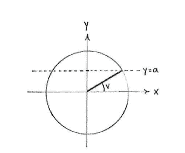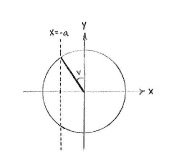Solution 4.3:3e
From Förberedande kurs i matematik 1
(Difference between revisions)
m |
|||
| Line 1: | Line 1: | ||
| - | {{ | + | The angle |
| - | < | + | <math>\frac{\pi }{2}+v</math> |
| - | {{ | + | makes the same angle with the positive |
| + | <math>y</math> | ||
| + | -axis as the angle | ||
| + | <math>v</math> | ||
| + | makes with the positive | ||
| + | <math>x</math> | ||
| + | -axis, and hence we see that the | ||
| + | <math>x</math> | ||
| + | -coordinate for | ||
| + | <math>\frac{\pi }{2}+v</math> | ||
| + | is equal to the | ||
| + | <math>y</math> | ||
| + | -coordinate for | ||
| + | <math>v</math>, but with a change of sign, i.e. | ||
| + | |||
| + | |||
| + | <math>\cos \left( \frac{\pi }{2}+v \right)=-\sin v=-a</math> | ||
[[Image:4_3_3_e-1.gif|center]][[Image:4_3_3_e-2.gif|center]] | [[Image:4_3_3_e-1.gif|center]][[Image:4_3_3_e-2.gif|center]] | ||
| + | |||
| + | |||
| + | angle | ||
| + | <math>v</math> | ||
| + | angle | ||
| + | <math>\frac{\pi }{2}+v</math> | ||
Revision as of 09:12, 10 October 2008
The angle \displaystyle \frac{\pi }{2}+v makes the same angle with the positive \displaystyle y -axis as the angle \displaystyle v makes with the positive \displaystyle x -axis, and hence we see that the \displaystyle x -coordinate for \displaystyle \frac{\pi }{2}+v is equal to the \displaystyle y -coordinate for \displaystyle v, but with a change of sign, i.e.
\displaystyle \cos \left( \frac{\pi }{2}+v \right)=-\sin v=-a
angle
\displaystyle v
angle
\displaystyle \frac{\pi }{2}+v


